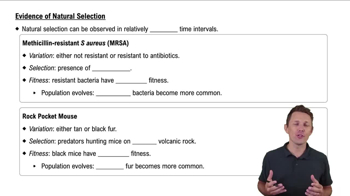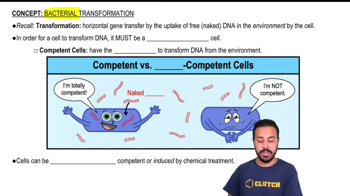Table of contents
- 1. Introduction to Biology2h 42m
- 2. Chemistry3h 40m
- 3. Water1h 26m
- 4. Biomolecules2h 23m
- 5. Cell Components2h 26m
- 6. The Membrane2h 31m
- 7. Energy and Metabolism2h 0m
- 8. Respiration2h 40m
- 9. Photosynthesis2h 49m
- 10. Cell Signaling59m
- 11. Cell Division2h 47m
- 12. Meiosis2h 0m
- 13. Mendelian Genetics4h 44m
- Introduction to Mendel's Experiments7m
- Genotype vs. Phenotype17m
- Punnett Squares13m
- Mendel's Experiments26m
- Mendel's Laws18m
- Monohybrid Crosses19m
- Test Crosses14m
- Dihybrid Crosses20m
- Punnett Square Probability26m
- Incomplete Dominance vs. Codominance20m
- Epistasis7m
- Non-Mendelian Genetics12m
- Pedigrees6m
- Autosomal Inheritance21m
- Sex-Linked Inheritance43m
- X-Inactivation9m
- 14. DNA Synthesis2h 27m
- 15. Gene Expression3h 20m
- 16. Regulation of Expression3h 31m
- Introduction to Regulation of Gene Expression13m
- Prokaryotic Gene Regulation via Operons27m
- The Lac Operon21m
- Glucose's Impact on Lac Operon25m
- The Trp Operon20m
- Review of the Lac Operon & Trp Operon11m
- Introduction to Eukaryotic Gene Regulation9m
- Eukaryotic Chromatin Modifications16m
- Eukaryotic Transcriptional Control22m
- Eukaryotic Post-Transcriptional Regulation28m
- Eukaryotic Post-Translational Regulation13m
- 17. Viruses37m
- 18. Biotechnology2h 58m
- 19. Genomics17m
- 20. Development1h 5m
- 21. Evolution3h 1m
- 22. Evolution of Populations3h 53m
- 23. Speciation1h 37m
- 24. History of Life on Earth2h 6m
- 25. Phylogeny2h 31m
- 26. Prokaryotes4h 59m
- 27. Protists1h 12m
- 28. Plants1h 22m
- 29. Fungi36m
- 30. Overview of Animals34m
- 31. Invertebrates1h 2m
- 32. Vertebrates50m
- 33. Plant Anatomy1h 3m
- 34. Vascular Plant Transport1h 2m
- 35. Soil37m
- 36. Plant Reproduction47m
- 37. Plant Sensation and Response1h 9m
- 38. Animal Form and Function1h 19m
- 39. Digestive System1h 10m
- 40. Circulatory System1h 49m
- 41. Immune System1h 12m
- 42. Osmoregulation and Excretion50m
- 43. Endocrine System1h 4m
- 44. Animal Reproduction1h 2m
- 45. Nervous System1h 55m
- 46. Sensory Systems46m
- 47. Muscle Systems23m
- 48. Ecology3h 11m
- Introduction to Ecology20m
- Biogeography14m
- Earth's Climate Patterns50m
- Introduction to Terrestrial Biomes10m
- Terrestrial Biomes: Near Equator13m
- Terrestrial Biomes: Temperate Regions10m
- Terrestrial Biomes: Northern Regions15m
- Introduction to Aquatic Biomes27m
- Freshwater Aquatic Biomes14m
- Marine Aquatic Biomes13m
- 49. Animal Behavior28m
- 50. Population Ecology3h 41m
- Introduction to Population Ecology28m
- Population Sampling Methods23m
- Life History12m
- Population Demography17m
- Factors Limiting Population Growth14m
- Introduction to Population Growth Models22m
- Linear Population Growth6m
- Exponential Population Growth29m
- Logistic Population Growth32m
- r/K Selection10m
- The Human Population22m
- 51. Community Ecology2h 46m
- Introduction to Community Ecology2m
- Introduction to Community Interactions9m
- Community Interactions: Competition (-/-)38m
- Community Interactions: Exploitation (+/-)23m
- Community Interactions: Mutualism (+/+) & Commensalism (+/0)9m
- Community Structure35m
- Community Dynamics26m
- Geographic Impact on Communities21m
- 52. Ecosystems2h 36m
- 53. Conservation Biology24m
17. Viruses
Viruses
Problem 7
Textbook Question
If you come down with the flu, should your physician prescribe an antibiotic for you? Explain why or why not.
 Verified step by step guidance
Verified step by step guidance1
Understand the nature of the flu: The flu is caused by the influenza virus, which is a type of pathogen classified as a virus, not a bacterium. Antibiotics are specifically designed to target bacterial infections, not viral infections.
Learn how antibiotics work: Antibiotics function by interfering with processes essential to bacterial survival, such as cell wall synthesis, protein synthesis, or DNA replication. Viruses, however, do not have these structures or processes, making antibiotics ineffective against them.
Consider the risks of unnecessary antibiotic use: Prescribing antibiotics for a viral infection like the flu can contribute to antibiotic resistance, a serious global health issue where bacteria evolve to resist the effects of antibiotics, making future bacterial infections harder to treat.
Explore appropriate treatments for the flu: Instead of antibiotics, antiviral medications may be prescribed to target the influenza virus directly. Supportive care, such as rest, hydration, and over-the-counter medications, can also help alleviate flu symptoms.
Discuss the importance of accurate diagnosis: Physicians should carefully diagnose the cause of the illness. If a secondary bacterial infection (e.g., pneumonia) develops alongside the flu, antibiotics may be necessary to treat the bacterial component of the illness.
 Verified video answer for a similar problem:
Verified video answer for a similar problem:This video solution was recommended by our tutors as helpful for the problem above
Video duration:
2mPlay a video:
Was this helpful?
Key Concepts
Here are the essential concepts you must grasp in order to answer the question correctly.
Viral vs. Bacterial Infections
The flu is caused by the influenza virus, which is a viral infection. Antibiotics are effective against bacterial infections, not viral ones. Understanding this distinction is crucial because prescribing antibiotics for viral infections like the flu does not treat the illness and can contribute to antibiotic resistance.
Recommended video:
Guided course

Viral Genetics
Antibiotic Resistance
Antibiotic resistance occurs when bacteria evolve and become resistant to the effects of medications that once killed them or inhibited their growth. Overprescribing antibiotics, especially for viral infections, can accelerate this process, making bacterial infections harder to treat in the future.
Recommended video:

Evidence of Natural Selection
Symptomatic Treatment
For viral infections like the flu, treatment typically focuses on alleviating symptoms rather than curing the infection. Physicians may recommend rest, hydration, and over-the-counter medications to relieve fever and aches, rather than antibiotics, which do not address the underlying viral cause.
Recommended video:
Guided course

Bacterial Transformation
Related Videos
Related Practice
Textbook Question
Compare and contrast the bacteriophage lytic cycle and lysogeny by addressing (1) the rate of replication of the viral genome, (2) production of virions, and (3) effect on the host cell.
1772
views


